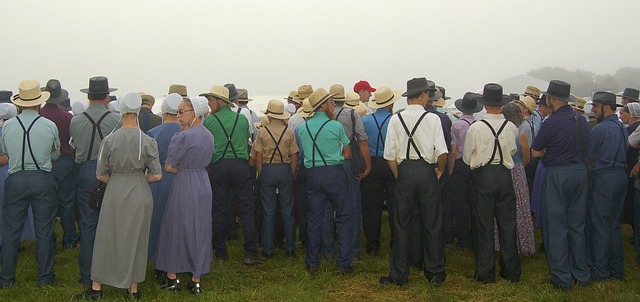The Amish and the Shakers are two distinct religious groups that emerged in the United States during the 18th and 19th centuries. While both groups share certain similarities, such as their commitment to simplicity and communal living, they also have significant differences in their beliefs, practices, and lifestyles. This article will provide an introduction to the Amish and the Shakers, highlighting their key characteristics and contrasting aspects.
Table of Contents
Lifestyle Differences Between Amish and Shakers
The Amish and the Shakers are two religious groups that have a long history in the United States. While they both have similar beliefs and values, there are some distinct lifestyle differences between the two. In this article, we will explore these differences and gain a better understanding of the unique ways in which the Amish and the Shakers live their lives.
One of the most noticeable differences between the Amish and the Shakers is their approach to technology. The Amish are known for their rejection of modern technology, preferring to live a simple and traditional lifestyle. They do not use electricity, drive cars, or have televisions. Instead, they rely on horse-drawn carriages and oil lamps for transportation and lighting. In contrast, the Shakers embrace technology and innovation. They were known for their skilled craftsmanship and were early adopters of inventions such as the washing machine and the circular saw.
Another difference between the Amish and the Shakers is their approach to community life. The Amish place a strong emphasis on community and live in close-knit, tight-knit communities. They often live in large extended families and work together on farms and other communal projects. The Shakers, on the other hand, live in celibate communities. They believe in communal living and share all property and resources. They do not marry or have children, and their communities are often made up of individuals who have chosen to join the Shaker way of life.
Religious practices also differ between the Amish and the Shakers. The Amish are a Christian denomination and follow a strict interpretation of the Bible. They attend church services regularly and place a strong emphasis on prayer and worship. The Shakers, on the other hand, have a unique religious practice. They believe in the equality of the sexes and practice ecstatic worship, which involves singing, dancing, and shaking. They are known for their lively and energetic worship services.
In terms of clothing, the Amish and the Shakers also have distinct styles. The Amish dress in plain and modest clothing, with women wearing long dresses and men wearing simple shirts and pants. They do not use buttons or zippers and instead fasten their clothing with hooks and eyes. The Shakers, on the other hand, are known for their distinctive and colorful clothing. They believe that clothing should be functional and comfortable, and their garments often feature bright colors and unique patterns.
Despite these differences, both the Amish and the Shakers share a commitment to simplicity, humility, and a strong work ethic. They both value hard work and believe in living a life of service to others. Both groups have made significant contributions to American society through their craftsmanship, agriculture, and commitment to community.
In conclusion, while the Amish and the Shakers have similar beliefs and values, there are distinct lifestyle differences between the two. The Amish reject modern technology and live a simple and traditional lifestyle, while the Shakers embrace innovation and live in celibate communities. Their religious practices, clothing styles, and approach to community life also differ. However, both groups share a commitment to simplicity, humility, and hard work. Understanding these differences can help us appreciate the unique ways in which the Amish and the Shakers live their lives and contribute to society.
Religious Beliefs and Practices of Amish and Shakers

The Amish and the Shakers are two religious groups that have captured the curiosity of many people. Both groups have unique beliefs and practices that set them apart from mainstream society. In this article, we will explore the religious beliefs and practices of the Amish and the Shakers, and compare how they differ from each other.
The Amish are known for their simple and traditional way of life. They believe in living a life of humility and separation from the world. The Amish value community and family, and they prioritize the needs of the group over individual desires. They believe in the literal interpretation of the Bible and strive to live according to its teachings. The Amish reject modern technology and prefer to live a simple and self-sufficient lifestyle.
On the other hand, the Shakers have a more communal way of life. They believe in celibacy and live in gender-segregated communities. The Shakers believe in the equality of all people and practice a form of communal living where all property is held in common. They believe in the presence of God in all aspects of life and strive for perfection in everything they do. The Shakers are known for their beautiful craftsmanship and their unique style of furniture.
While both the Amish and the Shakers have a strong emphasis on community, they differ in their approach to technology. The Amish reject modern technology, while the Shakers embrace it. The Amish believe that technology can lead to worldly temptations and distractions from their faith. They prefer to live a simple and self-sufficient lifestyle, relying on traditional methods of farming and craftsmanship. In contrast, the Shakers believe that technology can be used to enhance their way of life. They embrace modern inventions and use them to improve their productivity and efficiency.
Another difference between the Amish and the Shakers is their approach to worship. The Amish worship in private homes or in simple meetinghouses. Their worship services are characterized by simplicity and humility, with a focus on prayer, singing, and the reading of scripture. The Amish believe in the importance of a personal relationship with God and strive to live a life that is pleasing to Him.
The Shakers, on the other hand, have a more elaborate form of worship. They believe in the importance of music and dance as a form of worship. The Shakers are known for their lively and energetic worship services, where they sing and dance in praise of God. They believe that through their music and dance, they can experience a spiritual connection with the divine.
In conclusion, the Amish and the Shakers have distinct religious beliefs and practices that set them apart from mainstream society. While both groups value community and simplicity, they differ in their approach to technology and worship. The Amish reject modern technology and prefer a simple and self-sufficient lifestyle, while the Shakers embrace technology and use it to enhance their way of life. The Amish worship in private homes or meetinghouses, focusing on prayer and scripture, while the Shakers have lively worship services that incorporate music and dance. Despite their differences, both the Amish and the Shakers share a deep faith and a commitment to living a life that is pleasing to God.
Architectural Styles of Amish and Shaker Communities
When it comes to architectural styles, the Amish and Shaker communities have distinct and unique characteristics. Both groups have a rich history and a strong commitment to their religious beliefs, which is reflected in their architectural choices. While there are similarities between the two, there are also notable differences that set them apart.
One of the key differences between Amish and Shaker architecture is the use of materials. The Amish prefer to use natural materials such as wood, stone, and brick, while the Shakers often opt for more durable and practical materials like metal and concrete. This difference in material choice is a reflection of their respective beliefs and values. The Amish believe in living a simple and humble life, and their use of natural materials reflects this philosophy. On the other hand, the Shakers believe in creating a functional and efficient living space, which is why they choose materials that are more durable and long-lasting.
Another difference between Amish and Shaker architecture is the overall design and layout of their buildings. Amish architecture is characterized by its simplicity and practicality. Amish homes are typically single-story structures with a rectangular shape and a gable roof. The interiors are often open and spacious, with minimal furniture and decorations. The focus is on functionality and creating a comfortable living space for the family.
In contrast, Shaker architecture is known for its clean lines and attention to detail. Shaker buildings often feature symmetrical designs and intricate woodwork. The interiors are meticulously organized and clutter-free, reflecting the Shaker belief in simplicity and order. Shaker buildings also often include communal spaces such as meetinghouses and workshops, which are designed to facilitate the community’s daily activities and gatherings.
Both Amish and Shaker architecture prioritize natural light and ventilation. Amish homes often have large windows that allow for ample sunlight to enter the space. This not only provides natural lighting but also helps to regulate the temperature inside the home. Shaker buildings also prioritize natural light, with large windows and skylights being common features. The use of natural light not only creates a pleasant and inviting atmosphere but also reduces the need for artificial lighting during the day.
In terms of color schemes, Amish architecture tends to favor neutral and earthy tones. The use of natural materials such as wood and stone is often left in its natural state, showcasing the beauty of the materials themselves. Shaker architecture, on the other hand, often incorporates brighter colors such as blues, greens, and yellows. These colors are used to create a sense of vibrancy and energy within the space.
In conclusion, while both Amish and Shaker architecture share a commitment to simplicity and functionality, there are distinct differences between the two. The Amish prefer natural materials and simple designs, while the Shakers opt for more durable materials and intricate woodwork. Despite these differences, both architectural styles prioritize natural light and ventilation, creating comfortable and inviting living spaces. Whether you prefer the simplicity of Amish architecture or the attention to detail of Shaker architecture, both styles offer a unique and charming aesthetic that reflects the values and beliefs of their respective communities.
Education and Technology Contrasts in Amish and Shaker Societies
Amish Compared To Shakers
Education and Technology Contrasts in Amish and Shaker Societies
When it comes to education and technology, the Amish and Shakers have some striking differences. These two religious communities, known for their simple and traditional way of life, have unique approaches to education and technology that reflect their core beliefs and values.
Let’s start with education. The Amish believe in a practical education that prepares their children for a life of manual labor and self-sufficiency. Formal education typically ends after the eighth grade, as the focus shifts to learning practical skills within the community. This emphasis on hands-on learning is rooted in the belief that education should be directly applicable to daily life.
In contrast, the Shakers placed a strong emphasis on education and intellectual pursuits. They believed that education was essential for personal growth and spiritual development. Shaker children received a comprehensive education that included reading, writing, math, and various trades. The Shakers even established their own schools, which were known for their high standards and rigorous curriculum.
Now, let’s turn to technology. The Amish have a well-known aversion to modern technology, which they view as a threat to their way of life and community values. They believe that excessive reliance on technology can lead to a loss of personal connections and a weakening of the community. As a result, the Amish limit their use of technology to what is deemed necessary for their daily lives. This means no electricity, no cars, and no telephones. Instead, they rely on traditional methods of transportation, such as horse and buggy, and use oil lamps for lighting.
On the other hand, the Shakers embraced technology and innovation. They saw technology as a means to improve their lives and increase efficiency. The Shakers were known for their inventions and advancements in various fields, including agriculture, manufacturing, and medicine. They were early adopters of labor-saving devices and were not afraid to experiment with new ideas. This progressive attitude towards technology set them apart from other religious communities of their time.
Despite these differences, both the Amish and Shakers share a commitment to simplicity and community. They value hard work, self-sufficiency, and a strong sense of belonging. While their approaches to education and technology may differ, these values remain at the core of their respective communities.
In conclusion, the Amish and Shakers have contrasting approaches to education and technology. The Amish prioritize practical education and limit their use of technology to preserve their way of life. In contrast, the Shakers place a strong emphasis on education and embrace technology as a means of progress. Despite these differences, both communities share a commitment to simplicity and community. Understanding these contrasts helps us appreciate the diversity of religious beliefs and practices that exist in our world.
Conclusion
In conclusion, the Amish and the Shakers are two distinct religious groups that have unique beliefs, practices, and lifestyles. While both groups emphasize simplicity and communal living, the Amish prioritize maintaining traditional agricultural practices and reject modern technology, while the Shakers focus on celibacy and gender equality. Despite their differences, both the Amish and the Shakers have made significant contributions to American history and continue to preserve their respective traditions and values.



